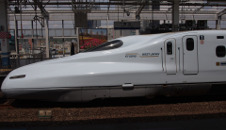Trains
Japan's four major islands, Honshu, Hokkaido, Kyushu and Shikoku are covered by an extensive and reliable network of railways. Trains are a very convenient way for visitors to travel around Japan. About 70 percent of Japan's railway network is owned and operated by the Japan Railways (JR), while the remaining 30 percent belongs to dozens of other private railway companies, especially in and around metropolitan areas.
Bullet Trains (Shinkansen)

Shinkansen: Traveling with maximum speeds of up to 150-200 mph The Shinkansen (nicknamed bullet train in English) is a network of high-speed railway lines in Japan operated by four Japan Railway Group companies.
Japan's main islands of Honshu and Kyushu are served by a network of high speed train lines that connect Tokyo with most of the country's major cities. Japan's high speed trains (bullet trains) are called shinkansen and are operated by Japan Railways (JR).
Running at speeds of up to 320 km/h (~200 mph), the shinkansen is known for punctuality (most trains depart on time to the second), comfort (relatively silent cars with spacious, always forward facing seats), safety (no fatal accidents in its history) and efficiency.
Buses (same as above)
Bus service is available in all cities, but can sometimes be a bit difficult for non-Japanese speaking visitors to use. In Tokyo, Osaka and some other large cities, buses serve as a secondary means of public transportation, complementing the train and subway networks. In cities with less dense train networks like Kyoto and Sasebo, buses are the main means of public transportation.
Buses also serve smaller towns, the countryside and national parks. Major cities are, furthermore, linked by highway and long distance buses.
JR operates long-distance buses between Tokyo and other major cities (JR Bus Network). Though travel takes longer, fares are cheaper than Shinkansen train fares. Other bus companies provide bus travel between major cities as well. Benefits of Night Buses include money saving on a night's accommodation, good riding comfort and economical travel even in daytime on routes good for sightseeing.
Taxis in Japan
To the average cost conscious traveler in Japan's large cities, taxis are an expensive and unnecessary alternative to the efficient public transportation. All Japanese taxis can be hailed on the street, from virtually anywhere you like, at most times and in most areas. However, some areas, like Ginza in Tokyo, do not allow taxis to stop anywhere but taxi stands, requiring passengers to line up at a taxi stand. Taxi stands are also the rule at railway and subway stations and major hotels in Tokyo, and can be especially crowded on Friday and Saturday nights, especially after the trains have stopped running.
In smaller cities, the countryside and in Kyoto, public transportation tends to be less convenient, thus taking a taxi from the nearest train station to your destination can be a good alternative. If you travel in groups of three or more people, taxis can also be an economical option on shorter distances.
Nearly all major airlines and airports offer flights to Japan. The countries own two leading airlines, Japan Airlines (JAL) and All Nippon Airways (ANA), both serve a broad range of international destinations. Japan's most important international airport is Tokyo's Narita Airport. Osaka's Kansai Airport, Tokyo's Hamada Airport, Nagoya's Central Japan Airport and Fukuoka Airport, which link with several Asian destinations. Many other Japanese airports have a small number of international flights, mainly to Korea and China.
Domestic air travel is dominated by the JAL Group and the ANA Group, which each consist of several airlines and serve over fifty airports across the country. In addition, there are several smaller airline companies competing with JAL and ANA on the country's most popular routes.
If you have time on your hands sailing by ferry in Japan can be a great way to cover long distances. Japan is made up of four main islands but there are hundreds of other islands scattered in the archipelago with the islands of Okinawa over a 1000km to the south. Japan's Inland Sea also has many small islands such as Shodoshima and Naoshima easily and cheaply reached by ferry.
The main routes of practical use to visitors would be from Osaka/Kobe (on Honshu) to Beppu/Oita (on Kyushu), Niigata on the Japan Sea coast to Otaru/Sapporo (Hokkaido) and Sado Island, Nagoya and Sendai to Tomokomai in southern Hokkaido and the ferry routes connecting Fukuoka in Japan with Busan in Korea and the boats to Naha in Okinawa from Tokyo, Osaka and Kagoshima.
The cheapest accommodation on Japan's ferries is in often cramped, communal, large tatami-mat rooms. The Hokkaido routes usually have women-only sections.
There is also a range of more expensive private first and second class cabins, and even suites, on board. Bicycles, motorbikes and cars also travel for an extra fee.